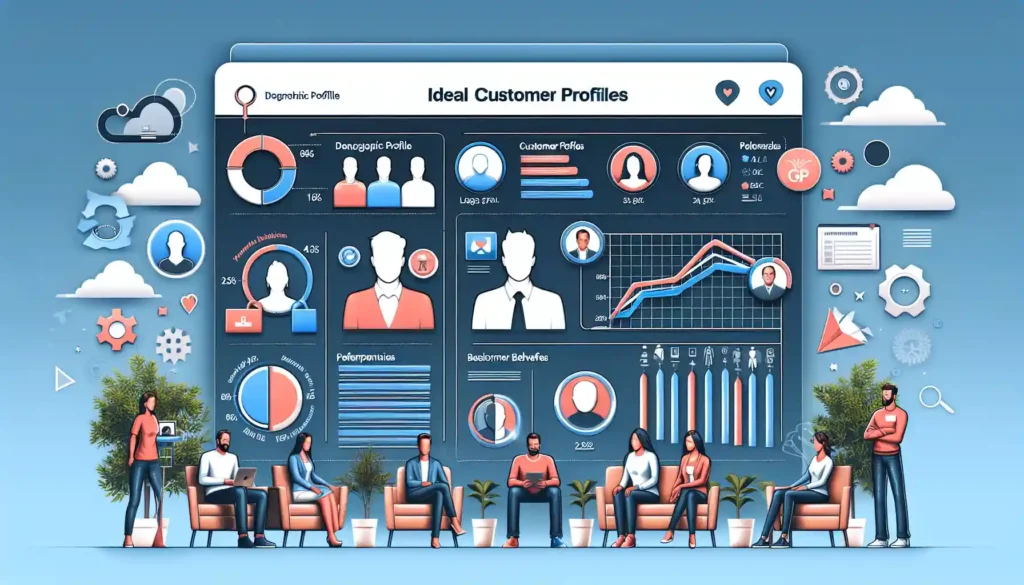
ICPs Meaning: Your Complete Guide to Ideal Customer Profiles

In the realm of B2B marketing, understanding your customer's needs and pain points is paramount for success. This is where the concept of ICP meaning, or Ideal Customer Profile, comes into play. An ICP represents the quintessential company that is most likely to gain value from your offerings, shaping your marketing and sales strategies around this ideal. By defining the characteristics and criteria of the perfect fit, businesses can focus their efforts more effectively, ensuring that their products and services reach those who will benefit the most.
The importance of an ICP cannot be overstated. As businesses navigate the complexities of account-based marketing (ABM), having a clear understanding of the icps meaning empowers teams to allocate resources wisely, target their messaging accurately, and maximize their return on investment. In this comprehensive guide, we will delve deep into the world of Ideal Customer Profiles, exploring their significance, methods for creation, and effective implementation strategies, helping your organization elevate its marketing approach.
Table of Contents
- The Significance of ICPs in B2B Marketing
- Key Differences Between Ideal Customer Profiles and Buyer Personas
- How to Identify Your Ideal Customer Profile
- Essential Elements of an Effective ICP
- Techniques for Analyzing Your Best Existing Customers
- Leveraging Customer Feedback to Enhance Your ICP
- Utilizing Competitor Research for New Business ICP Development
- The Role of Industry, Size, and Revenue in ICP Creation
- Updating and Maintaining Your ICP for Long-Term Success
- Practical Tips for Implementing Your ICP in Sales and Marketing Strategies
- Common Mistakes to Avoid When Developing Your ICP
- Case Studies: Successful ICP Implementation and Results
- To conclude about - icps meaning
The Significance of ICPs in B2B Marketing
Understanding Ideal Customer Profiles (ICPs) is essential for any B2B marketing strategy. An ICP serves as a blueprint for identifying the companies that are most likely to benefit from your products or services. This profile is not just a single customer; rather, it represents a segment of your market with shared characteristics. The influence of an ICP extends beyond marketing; it also plays a critical role in product development, customer support, and overall business strategy.
Understanding Ideal Customer Profiles (ICPs) in B2B Marketing
In essence, an ICP is a detailed description of your ideal client. This profile includes demographic, firmographic, and behavioral insights that make certain companies more suited to your offerings. For example, an ICP might specify companies in the technology sector with over 500 employees and a revenue greater than $10 million. With such clarity, marketing and sales teams can tailor their outreach efforts, ensuring the focus remains on those leads most likely to convert.
The Importance of ICPs in Account-Based Marketing (ABM)
In account-based marketing, where teams target specific companies rather than individual leads, the role of ICPs becomes even more critical. Understanding the icps meaning helps streamline efforts, allowing organizations to prioritize which accounts to pursue. By knowing which businesses align closely with the defined ICP, companies can create personalized marketing campaigns and tailor sales pitches that resonate, ultimately leading to a more efficient sales process.
Key Differences Between Ideal Customer Profiles and Buyer Personas
It's essential to differentiate between Ideal Customer Profiles and buyer personas, as both play distinct roles in a marketing strategy. While ICPs focus on the ideal company characteristics, buyer personas delve into the individual decision-makers within those companies. Here are key differences:
- Focus: ICPs emphasize company-level attributes, while buyer personas highlight individual characteristics.
- Purpose: ICPs guide target account selection, while buyer personas inform communication strategies.
- Data Sources: ICPs leverage firmographic data; buyer personas utilize customer interviews and surveys.
Janet, a marketer, may describe an ideal company (ICPs meaning) such as a SaaS firm with specific revenue. In contrast, her buyer persona might focus on John, the CIO of that firm, discussing his pain points and decision-making processes. Both are integral but serve different purposes in developing a comprehensive marketing strategy.
How to Identify Your Ideal Customer Profile
Identifying your Ideal Customer Profile involves a systematic approach to data collection and analysis. Here are steps to guide you:
- Analyze your current customers: Start with your best clients. Identify common traits among them regarding industry, size, revenue, and purchase behavior.
- Segment your customers: Group customers into segments based on common characteristics. This can help you see patterns that define your ICP.
- Utilize data analytics: Integrate your CRM and other data sources to analyze customer demographics and firmographics systematically.
- Gather feedback: Solicit insights from your sales team regarding which customers are easiest to work with and why.
All these steps contribute to an accurate understanding of which customers are the most valuable and would fit into your ICP.
Essential Elements of an Effective ICP
To craft an effective Ideal Customer Profile, certain key elements should be included:
- Industry: The sector where the ideal companies operate, whether finance, healthcare, technology, etc.
- Company Size: The number of employees, which can significantly impact purchasing decisions.
- Annual Revenue: Financial metrics indicating the company’s ability to invest in your products or services.
- Geographic Location: The regions where you operate or want to target customers.
- Challenges and Pain Points: Issues the potential customers face that your offerings can address.
- Required Solutions: Specific needs that your product or service fulfills.
By assembling these elements, you create a detailed and actionable profile that guides your marketing and sales strategies.
Techniques for Analyzing Your Best Existing Customers
To refine your ICP, it's crucial to analyze your best existing customers thoroughly. Employing the following techniques can enhance your understanding:
- Customer Surveys: Conduct surveys to gather insights on customer satisfaction and why they chose your product over competitors.
- Interviews: Speaking directly with your best customers can reveal motivations, challenges, and future needs.
- Churn Analysis: Identify elements shared by customers who left and understand what went wrong.
- Usage Analytics: Examine how different customers use your product, which features are most valuable, and why.
These techniques provide a comprehensive look at what makes your best customers a great fit—insights that can directly enhance your ICP.
Leveraging Customer Feedback to Enhance Your ICP
The voice of your customer is a powerful tool in refining your ICP. By actively seeking out and leveraging customer feedback, businesses can make informed adjustments to their Ideal Customer Profiles. Here is how feedback can be utilized:
- Focus Group Discussions: Hold discussions to dive deep into customer experiences and perceptions of your products.
- Net Promoter Score (NPS): Use NPS surveys to gauge customer loyalty and onboard the feedback to refine your targeting.
- Online Reviews: Analyze reviews on platforms like G2 or Capterra to find common praises or recurring complaints.
- Social Media Insights: Monitor conversations about your brand on social media to discover what excites or frustrates your customers.
Incorporating this feedback ensures that your Ideal Customer Profile stays aligned with customer expectations, enabling better targeting and improved customer engagement.
Utilizing Competitor Research for New Business ICP Development
Understanding your competitors is a significant component in developing your ICP. By analyzing their customers, products, and marketing strategies, you can glean insights that inform your own ICP. Consider these areas for research:
- Target Audience: Whom do your competitors target? Identify gaps in their outreach that your business can exploit.
- Customer Pain Points: What challenges are your competitors addressing? Understanding unmet needs can help refine your ICP further.
- Marketing Tactics: Analyze how your competitors position their products and how they communicate with their ideal customers.
- Product Reviews: Investigate reviews of competitors’ products to find potential weaknesses that your product can capitalize on.
Competitor research is not about imitation but leveraging insights to shape a distinct and effective ICP.
The Role of Industry, Size, and Revenue in ICP Creation
When developing your Ideal Customer Profile, industry, company size, and revenue are three pillars that should receive careful consideration:
- Industry: Different industries have unique needs. By identifying which sectors align best with your offerings, you can create a more targeted ICP.
- Company Size: Smaller startups may have different budget constraints and decision-making processes compared to large enterprises.
- Revenue: High-revenue companies may expect premium features, whereas budget-sensitive businesses will seek cost-effective solutions.
By understanding how each of these elements integrates and impacts your target audience, you can specify your ICP more accurately, ensuring all marketing and sales efforts are appropriately tailored.
Updating and Maintaining Your ICP for Long-Term Success
The market is ever-changing, and Ideal Customer Profiles must be regularly evaluated and updated as business priorities shift. Consider the following strategies:
- Regular Data Reviews: Periodically evaluate your customer data to identify trends and shifts that may indicate the need for an ICP update.
- Feedback Loop Creation: Establish a consistent method for gathering customer insights to keep your ICP relevant.
- Market Analysis: Stay attuned to industry changes, emerging needs, and shifts in technology to be proactive rather than reactive.
- Sales Team Input: Regularly consult your sales team to understand which companies they’re engaging with and why.
Maintaining an up-to-date ICP ensures your marketing strategies remain effective, and your sales teams stay focused on qualifying leads that fit your evolving business landscape.
Practical Tips for Implementing Your ICP in Sales and Marketing Strategies
Once the Ideal Customer Profile is established, implementing it effectively across your sales and marketing strategies is crucial. Here are practical tips:
- Alignment of Teams: Ensure marketing, sales, and customer service teams all understand the ICP to foster message consistency.
- Personalized Marketing Campaigns: Use your ICP to design targeted campaigns that resonate with specific attributes and challenges faced by ideal customers.
- Lead Scoring: Develop a lead scoring system tied to your ICP that helps prioritize leads based on their fit and potential value.
- Content Creation: Tailor marketing content and collateral that directly addresses the pain points and needs outlined in your ICP.
Implementing the ICP across all business dealings creates a unified front, making it easier to approach and convert target accounts.
Common Mistakes to Avoid When Developing Your ICP
While creating an Ideal Customer Profile can substantially improve marketing effectiveness, there are common pitfalls to be wary of:
- Overgeneralization: Avoid creating an ICP that is too broad. Specificity is crucial to effectively target potential customers.
- Neglecting Data: Basing your ICP solely on gut feelings or anecdotal evidence without backing it up with data can lead to ineffective targeting.
- Static Approach: An ICP is not a one-and-done project. Failing to revisit and update your ICP can render it obsolete.
- Being Too Rigid: Stay open to evolving your ICP as customer needs and industry landscapes shift.
By recognizing and avoiding these common mistakes, businesses can ensure their Ideal Customer Profile is both robust and effective.
Case Studies: Successful ICP Implementation and Results
Understanding the practical applications of creating an Ideal Customer Profile can significantly enhance comprehension. Here are a few case studies demonstrating successful ICP implementation:
Case Study 1: SaaS Company Revamps Their ICP
A SaaS company specializing in project management tools found that their previous ICP was too focused on large enterprises. By analyzing their customer base and utilizing feedback, they identified that mid-sized businesses yielded higher customer satisfaction and lower churn. By adjusting their ICP to focus on mid-sized companies, they personalized their marketing efforts and saw a 40% increase in lead conversion rates.
Case Study 2: Tech Startup Targets a Niche
A tech startup initially cast a wide net, targeting various industries. After conducting competitor research and establishing a detailed ICP focused on healthcare organizations, the startup pivoted their messaging effectively. This informed strategy led to winning several contracts with significant healthcare providers, demonstrating the power of a well-defined ICP.
To conclude about - icps meaning
The journey of understanding icps meaning offers invaluable insights for B2B marketers aiming to sharpen their strategies in a competitive landscape. From identifying and analyzing existing customers to maintaining and implementing Ideal Customer Profiles, the process is essential for targeted marketing. By leveraging insights from various data sources, including customer feedback and competitor analysis, businesses can develop ICPs that lead to increased conversions and a stronger market presence.
As markets evolve and customer needs shift, remaining attentive to these changes ensures that your ICP stays relevant and effective. Embracing this dynamic nature allows businesses to not only attract but also effectively engage their ideal customers. Ultimately, prioritizing a well-defined Ideal Customer Profile can set your organization on a trajectory for sustained growth and success.
If you want to know other articles similar to ICPs Meaning: Your Complete Guide to Ideal Customer Profiles and can visit the categoryMarketing.
Go up






Leave a Reply